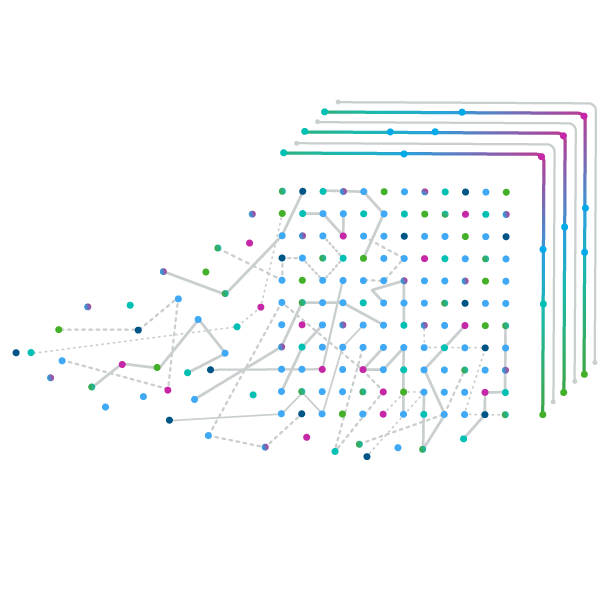IQVIA IM Strategy solutions and advisory services are designed to optimize data, analytics and insights across healthcare organizations

We obviously saw the ".com" boom, and the revolution of the internet, if you will, around the turn of the century. And a company like Nike would have said to you, "I make shoes, and I used to sell those shoes in my own brick and mortar Nike stores. I used to sell them in department stores around the world.” And then with the Internet, it became, “I’ll sell them on Nike.com, I'll sell them on Amazon, I'll sell them on..." so forth.
I am fortunate that I get to speak with senior executives, be that C-suite members of various large life sciences and or healthcare companies. I think the challenge that they would say to you consistently is, "I am attempting to stand up multiple customer engagement models, all at the same time." So why I bring that metaphor up for this example is, I'm a life science company, I make medicine. But primarily, I had a business model where my customer engagement model was: “I used a very large field force of human beings that primarily drove the awareness trial and usage of this new medicine, and I educated the masses through, largely, a push-based model”. Well now, you have to stand up a pull-based model. The equivalent of Nike moving to the internet and saying, "Okay, wherever you want to find these things, I'm going to make my shoes available." It's an "all of the above." It's not, "I do one" or "I do the other," it's "and." So, how do I abandon what may have worked for me in the past when the calculus of the marketplace was one set of variables or one archetype? And now I have multiple archetypes, and I have to use multiple customer engagement models to do that, basically simultaneously, all while my employees work from home.
If a CIO is doing their job brilliantly, hopefully in partnership with companies like IQVIA, we should be able to power a much better experience for that ultimate end user, the patient, the healthcare professional, the healthcare organization, so that the information that they need to actually serve and there's always a patient at the other end of that equation, for that patient to get the care that they need, the right information, the right medicine at the right time for the appropriate patient. That CIO has a chance to re-imagine that kind of value chain if you will.
The world is now moving at maybe a more dynamic pace than at any point in human history, and the capabilities that you have at your disposal, be that your access to data capabilities, analytical capabilities, or technology capabilities, is increasing at the speed of Moore's law, let's say. So how do I, as an organization, take advantage of this confluence of activities and I'm a life science company whose primary organic capability is the discovery and development and manufacturing of a medicine? Should I try to take on the organic development of some of those same technology or software capabilities? Or should I go partner with somebody who actually just does that and moves at the pace that that organization moves at? I think what you're going to find is the most successful companies are going to be those that partner with a much larger ecosystem than they may have in the past.
We've gone through the same rapid acceleration that our customers have, and what we're recommending that our customers do. I think the reason that IQVIA's commercial engagement model is valued, and or differentiated, is really because of the focus we have on seamless engagement, meaning whether that's a patient healthcare professional or a health care organization, the integrated solutions that we provide at IQVIA to our clients and customers will be able to actually engage seamlessly, regardless of which medium. Meaning, let's say a patient is engaging via their phone or laptop, whether they're attending a webinar or whether it's a person that they're meeting with face to face, like a nurse navigator, whatever that may be, that will be paramount.
The best representatives are going to be the ones that are actually able to triage all of the information, and stakeholders, and services, and knowledge, and capabilities that are sitting behind them. Now, the challenge is the reality is the number of stakeholders has actually increased, the number of channels that the customer is going to use to engage with that pharma company or that biotech company has increased, the number of data points in that kind of calculus has increased. So, if you're a human trying to deliver a brilliant customer experience and to try to solve an unmet need for the healthcare professional or healthcare organization, it's a very difficult task to be able to say: "how am I going to be able to handle that quote unquote manually or on my own?".
What this means for IQVIA technologies, our services and the capabilities that we develop, is we're going to be focused today, and in the future on building modular interoperable capabilities, either data and analytics, a service, a technology that we know is going to play very well in what we know to be a very varied and heterogeneous ecosystem. And what that means for our clients, or our customers is that they're not coming to us where we have a closed ecosystem where they simply have to buy everything that we offer. No, the reality is they could pick and choose the data, the services, the technology that they need, and those data, services, and technology will plug in seamlessly in as heterogeneous an ecosystem as we may find ourselves in, partnering with one of those large pharma companies or that small biotech company, so that the data, the services, and the technologies that we provide at IQVIA will play very nicely in that ecosystem today. But maybe more importantly, we know they'll play very nicely in an ecosystem that's changing tomorrow.
Related solutions
Get alignment on what to measure, eliminate duplicative reporting and make complex data easier to manage with our easy-to-deploy analytics suite.
Connect data across your organization with master data management and data warehouse capabilities, and transform the way you make business decisions.
Combine data science, technology, and analytics driven by artificial intelligence to support new efficiencies and business insights -- without additional capital investment.


























